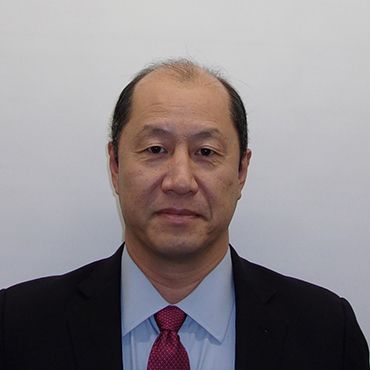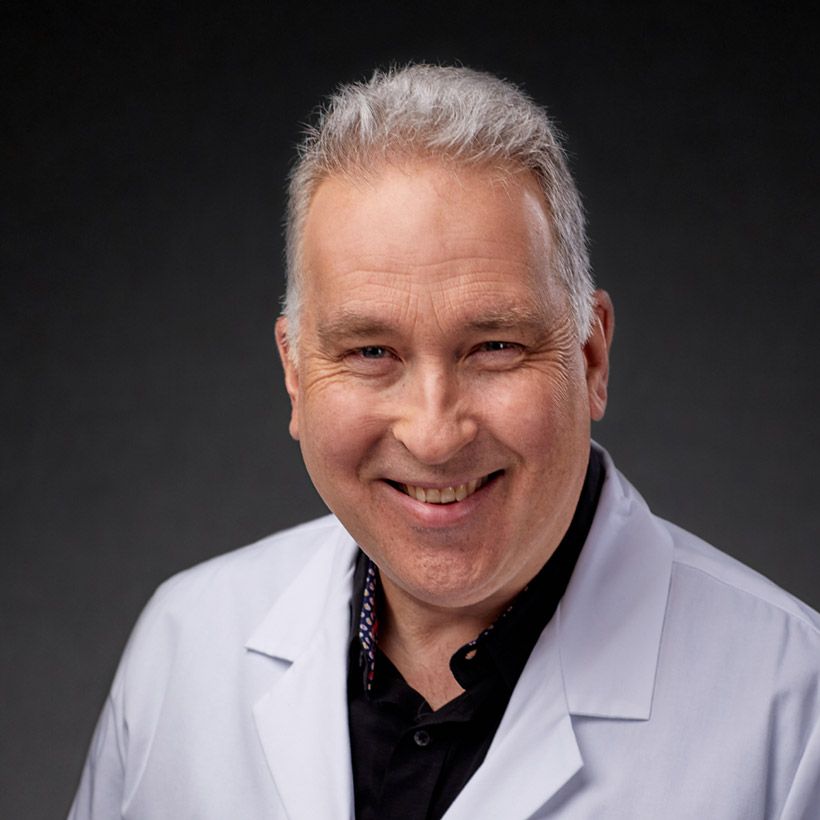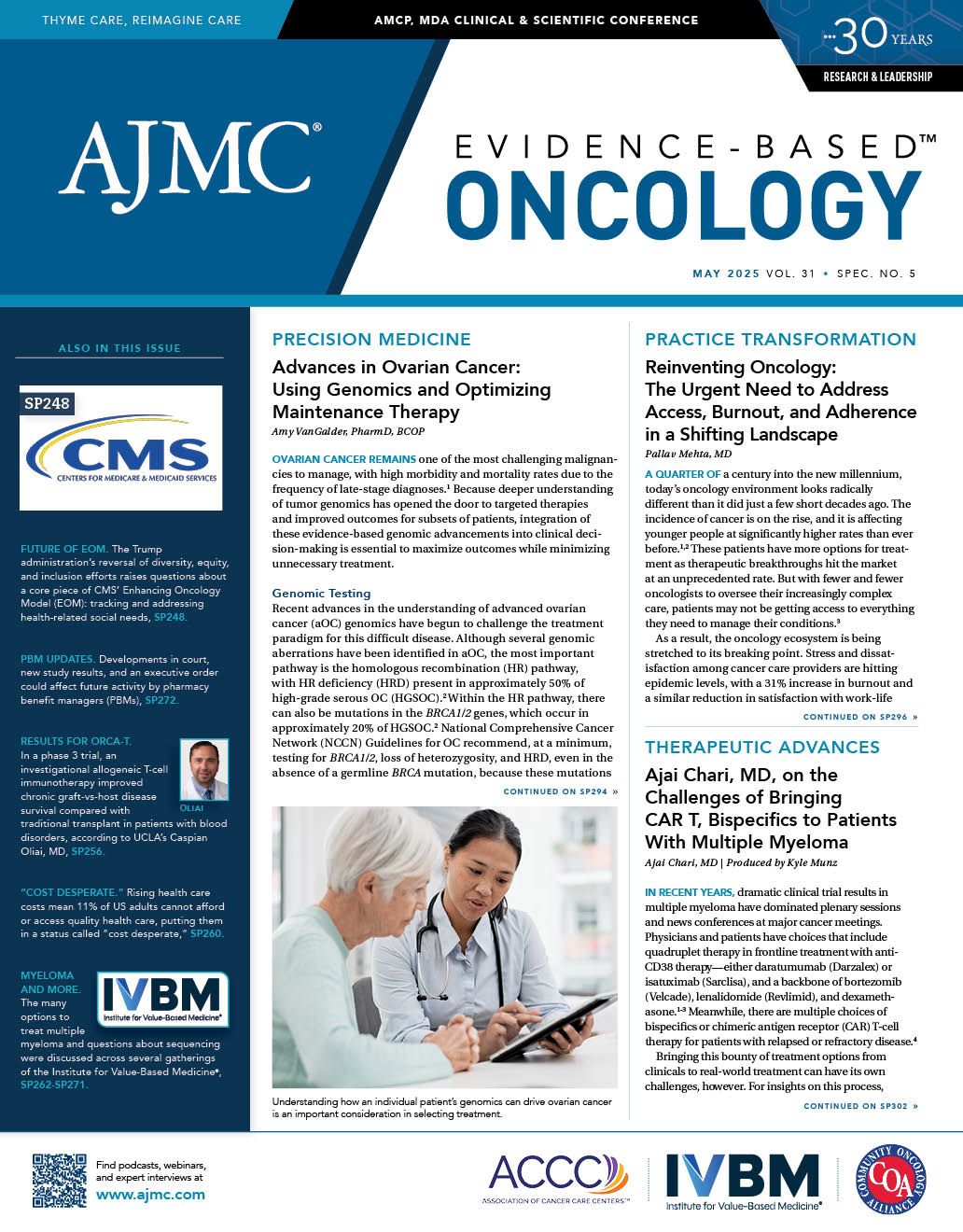- Center on Health Equity & Access
- Clinical
- Health Care Cost
- Health Care Delivery
- Insurance
- Policy
- Technology
- Value-Based Care
Translating Best Practices and Ensuring Equitable Care as the Treatment Landscape Evolves
With an ever-changing treatment landscape due to innovations, translating best practices to the community and ensuring equitable cancer care are crucial. At a recent Institute for Value-Based Medicine® event in Phoenix, Arizona, panel discussions covered the treatment of breast cancer in the community setting, innovations in treatment for multiple myeloma, the advancement of immunotherapy for non–small cell lung cancer, and addressing health equity and social determinants of health.
Breast Cancer in the Community
Christopher Chen, MD, MBA | Image credit: City of Hope

Community oncologists often have the job of translating academic best practices in breast cancer into the community setting, which can come with a set of challenges and requires careful strategy, as discussed during the first panel of the night, moderated by Christopher Chen, MD, MBA, medical oncologist and hematologist at City of Hope, Phoenix.
For patients with hormone receptor–positive, HER2-negative early-stage breast cancer, there are 2 cyclin-dependent kinase (CDK) 4/6 inhibitors, ribociclib (Kisqali; Novartis) and abemaciclib (Verzenio; Eli Lilly), that can be used as an adjuvant treatment.1,2 Qing Zhao, MD, breast medical oncologist with Banner MD Anderson, explained that the phase 3 monarchE (abemaciclib, NCT03155997) and NATALEE (ribociclib, NCT03701334) trials both showed improvements in invasive disease-free survival.3,4 However, a 2- to 3-year commitment of treatment with a CDK4/6 inhibitor is “not without toxicities,” she said, so whether or not to start someone on these treatments will depend a lot on individual scenarios.
With multiple options, there will always be a discussion of which medication makes the most sense, but the financial issues are also a concern, said Anu Batra, MD, medical oncologist at Ironwood Cancer. Especially with older patients, there is a concern that they’ll be spending their retirement savings on their treatment.
“With the NATALEE trial, the data [are] early, and it would be interesting to know if this PFS [progression-free survival] actually translates into [overall survival], which will eventually help make patients’ decision with regards to the financial decision-making that’s involved in taking these medications, along with the clinical indication, which definitely is very valuable,” Batra said.
When there are good clinical data, it can be easy to forget how much of a financial burden these drugs have on patients, added Elisa Tso Bomgaars, MD, medical oncologist at Ironwood Cancer.
Antibody-drug conjugates (ADCs) are another example of an emerging treatment in breast cancer with multiple options now approved and more in the pipeline. The challenge for providers now is how to sequence these medications, Batra noted, because there are no clear data on what leads to resistance.
“We have heard anecdotal case reports where sometimes the second ADC results in a longer disease-free [survival or] longer PFS as compared [with] using the first ADC…. Whether or not to sequence them back-to-back or space them with chemotherapies is, again, an unanswered question,” she said.
One evolution in the breast cancer space has been to use HER2-low or -ultralow status for treatment decisions. HER2-ultralow is a very new concept, and panelists agreed that they have worked with pathologists on a case-by-case basis to take a second look at patients diagnosed before this status was recognized. However, this isn’t being done in any routine way, and the pathologists aren’t reimbursed for that work.
For the future of metastatic breast cancer, Zhao noted that circulating tumor DNA (ctDNA) is an exciting area of research. With more data being reported and modern trials more regularly collecting ctDNA, there should be enough data gathered in a few years to help direct management of breast cancer in the clinic.
Batra highlighted the move to use selective estrogen receptor degraders in early breast cancer. Ironwood is conducting the phase 3 CAMBRIA-1 trial (NCT05774951) studying camizestrant (AstraZeneca) in endocrine receptor–positive/HER2-negative early breast cancer after a few years of adjuvant endocrine therapy. In addition, Ironwood is conducting the phase 3 ASCENT-07 trial (NCT05840211), which is looking at moving sacituzumab govitecan (Trodelvy; Gilead) up in treatment.
Evolution of Immunotherapy in Lung Cancer
Jason Niu, MD, PhD | Image credit: Banner MD Anderson

With advancements in immunotherapy for the treatment of lung cancer, there is a need for clinicians to tailor treatment approaches based on patient-specific factors. Jason Niu, MD, PhD, codirector of the lung cancer program at Banner MD Anderson Cancer Center, moderated the discussion with the following:
- Pranshu Bansal, MD, medical oncologist with Ironwood Cancer;
- Amit Kulkarni, MD, thoracic medical oncologist with City of Hope, Phoenix, and
- Azam Farooqui, MD, medical oncologist with Ironwood Cancer.
Immunotherapy, said Kulkarni, is the “backbone of treatment of lung cancer, both in non–small cell and small [cell] lung cancer.” Almost all settings of lung cancer have an immunotherapy approved, but the biggest breakthrough has been in the neoadjuvant setting, he said.
“I think it’s completely turned around how we treat early-stage lung cancer, and especially the outcomes that we’ve been seeing in patients who have a complete pathologic response,” he said.
Farooqui highlighted the importance of being able to create more personalized treatment plans now in lung cancer treatment. “Gone are the days that we have to kind of throw everything at everybody,” he said.
Tailoring treatments to patients is much easier, allowing physicians to move away from a one-size-fits-all approach to a more nuanced strategy based on biomarkers such as PD-L1 levels. Research now indicates that if a patient has high PD-L1 expression (≥ 50%), they can receive single-agent immunotherapy.5 While his practice generally uses single-agent immunotherapy in these cases, there are instances when chemotherapy may be added, such as when patients have a high disease burden and he wants to debulk them faster or get a faster response.
For patients with squamous cell carcinoma and low PD-L1, Bansal prefers to use a combination of PD-L1 and CTLA-4 inhibitors. For patients with a comutation, he tries to choose a double immunotherapy.
Kulkarni echoed that comutation is an important consideration in addition to PD-L1 burden of 50% or more, which he noted is sort of an arbitrary cutoff. KRAS mutations are independent prognostic and predictive biomarkers, and he prefers doublet immunotherapy for patients with that mutation who have a low PD-L1 expression. There are also data suggesting that STK11 is a negative prognostic and predictive biomarker, he added.
For management of patients with oligometastatic disease, chemotherapy with immunotherapy followed potentially by radiation therapy based on the response is typical, Bansal said. However, if the patients are older and smokers with high PD-L1 expression, then a single-agent immunotherapy may be a consideration.
However, there should be a better definition of oligometastatic, noted Kulkarni. “Is it 5 sites? Is it 2 sites? Is it 3 sites?” he asked. “I think that has to be clarified better.” The best data are based on evidence of 2 to 3 sites, especially in patients with no actionable genomic alterations. For patients with actionable genomic alterations, consolidated treatments in this setting can improve PFS, but the data for immunotherapy in this space are still evolving.
In terms of treatment in the adjuvant vs neoadjuvant setting, Bansal indicated he prefers adjuvant therapy because he’s had patients whom he treated in the neoadjuvant setting who relapsed years later. Farooqui said he had similar experiences, since some cases have been on the more advanced side and there was no pathological complete response, which makes him recommend adjuvant therapy.
Kulkarni, though, prefers neoadjuvant therapy.
“I’ve been a very early adopter of neoadjuvant therapy, because I think you have so many reasons for the immunotherapy to work better: The tumor is still there [and there is a] higher surface area of encountering a tumor neoantigen, things like that,” he said. “And then you can see an up-front response.”
Quad Therapy, MRD, and Innovations in Multiple Myeloma
Jeffrey Schriber, MD, FRCP | Image credit: City of Hope

The next panel discussed current and emerging treatment strategies for multiple myeloma, focusing on up-front therapy, maintenance approaches, minimal residual disease (MRD) testing, and potential future developments in managing the disease, led by Jeffrey Schriber, MD, FRCP, medical director of the Blood and Marrow Transplant Program at City of Hope, Phoenix.
In up-front therapy, quadruplet regimens have become the standard of care, even for patients who are not candidates for a transplant, explained Jason Salganick, MD, director of myeloma at Ironwood Cancer. “If [the patient is] at all in decent shape, and many of them are, quad therapy is really not that much harder than triple drug therapy, so even the nontransplant candidates should be considered for quad therapy,” he explained.
Although the regimen of isatuximab (Sarclisa; Sanofi) plus bortezomib (Velcade; Takeda), lenalidomide (Revlimid; Bristol Myers Squibb), and dexamethasone (isa-VRd) was specifically studied in the non–transplant-eligible population,6 he prefers to use daratumumab (Darzalex; Janssen) plus VRd (D-VRd).7 Patients who are considered too frail receive the triplet therapy, he added.
There are so many options right now for patients with multiple myeloma that “it’s overwhelming,” Salganick said, which means there are options available when someone relapses after treatment.
“It’s like musical chairs,” said Rajneesh Nath, MD, hematologist with Banner MD Anderson. A patient with multiple myeloma will be treated with many different combinations over their lifetime, and the physician must make choices wisely to get the best response, put them on maintenance, and then go back to the therapy that the patient responded to first.
However, new treatments are still coming and moving up earlier in treatment. For instance, bispecific T-cell engager (BiTE) therapy is currently approved for patients who have relapsed or refractory multiple myeloma. Nath believes this therapy is coming to the front line, but trials are needed to understand what therapy should be paired with BiTEs and how different patients respond based on their risk profile.
Salganick added that giving BiTEs in the second line is better than in the fourth line, which is the current indication. Earlier in treatment, the patient’s immune system is “intact,” and BiTEs leverage the immune system to attack myeloma cells.
“The studies are now heavily coming out in second line, so first line is coming around the corner,” he said.
For years there have been data showing that patients who are MRD negative have better outcomes, but it hasn’t been clear what to actually do with the information. Salganick wondered whether having the attitude that “I’m going to do whatever I can and beat them up to get them into MRD [negative]” actually benefits patients. He only uses MRD status to guide treatment if patients want to get off therapy because they’re experiencing toxicity. If those patients are MRD positive, stopping therapy doesn’t make sense.
Most of the trials looking at MRD are with patients on maintenance therapy, and those patients are stopping therapy for 2 reasons, and they’re both bad, said Schriber. They either have adverse effects and need to stop treatment or their disease has come back. Neither of those scenarios are good, because he wants patients on treatment forever.
“But patients get tired of being on these [regimens] forever,” he said. “They have [adverse] effects that are real. If we have a way to measure MRD and it’s consistent, I think we’re going to get to a point in the not-too-distant future…[of] saying, ‘You’re on treatment for a certain period of time, you hit a 3-year mark, [and] you’re still MRD negative, [then] we’re going to stop [treatment].”
Treatments have evolved to a point where patients may be 20-year survivors who remain MRD positive. Nath said we’re at a point of a “functional cure,” and Salganick tells his patients that if he keeps them alive until they die of something other than their cancer, then that essentially was a cure. “We are not trying to cure our patients; we want to keep them alive,” he said.
The panel closed on a discussion of smoldering myeloma. First, the challenge is identifying who is considered a high-risk patient, but the phase 3 AQUILA study (NCT03301220) found that treating high-risk patients with daratumumab could significantly lower the risk of progression to active multiple myeloma or death compared with active monitoring.8
However, some think smoldering myeloma should be treated as full-blown multiple myeloma; there are studies to answer this question, because treating with daratumumab alone is a weak therapy for multiple myeloma.
“If you treat earlier, maybe you will actually say, ‘We will cure [the disease],’” Schriber said. “Maybe it won’t be a functional cure. Maybe it’ll be a real cure.”
Improving Health Equity for Diverse Populations
The evening closed with a discussion on social determinants of health, the challenges of health care access and clinical trial enrollment, and strategies to improve health equity across diverse populations.
Kevin Tulipana, DO, FHM | Image credit: City of Hope

Kevin Tulipana, DO, FHM, president of City of Hope, Phoenix, moderated the discussion with Brian Washburn, chief operating officer of Ironwood Cancer; Sujith Kalmadi, MD, chief medical officer of Ironwood Cancer; and Michael Gordon, MD, medical director and chief medical officer of HonorHealth.
Kalmadi noted that policy changes, such as expansion of insurance coverage to preexisting conditions and reduction of drug prices under the Inflation Reduction Act, have expanded patient access to care. However, the insurance exchanges have presented problems. Research showed that patients in Arizona participating in the exchanges were out of resources in approximately 25 months. “That coincides with the average survival in most solid tumors, which is kind of scary,” he said.
Recent research in Arizona found that 50% of a person’s health status was determined by social and environmental factors, but 34% was determined by individual health behaviors,9 highlighting a need to educate patients on prevention, Washburn said.
Outreach to underserved communities must be coupled with not only education but also an appreciation of that population’s history, Gordon noted. He provided the example of an attempt to increase the colonoscopy rate in Hispanic men, and what finally worked was accessing this population through women. Arizona Cancer Center had an aggressive program to get women their mammograms and gynecological exams and asked them to bring their husbands in to talk about colonoscopies.
“The point of creating relationships within the community becomes very, very important [to reach] minority [populations and] less-trusting groups,” he said.
References
1. Rosa K. FDA expands abemaciclib indication in HR+/HER2–, node+, high-risk breast cancer. OncLive. March 3, 2023. Accessed April 9, 2025. https://www.onclive.com/view/fda-expands-abemaciclib-indication-in-hr-node-high-risk-breast-cancer
2. Santoro C. FDA approves ribociclib for early breast cancer treatment with high recurrence rate. AJMC. September 17, 2024. Accessed April 9, 2025. https://www.ajmc.com/view/fda-approves-ribociclib-for-early-breast-cancer-treatment-with-high-recurrence-rate
3. Rastogi P, O’Shaughnessy J, Martin M, et al. Adjuvant abemaciclib plus endocrine therapy for hormone receptor–positive, human epidermal growth factor receptor 1–negative, high-risk early breast cancer: results from a preplanned monarchE overall survival interim analysis, including 5-year efficacy outcomes. J Clin Oncol. 2024;42(9):987-993. doi:10.1200/JCO.23.01994
4. Hortobagyi GN, Lacko A, Sohn J, et al. A phase III trial of adjuvant ribociclib plus endocrine therapy versus endocrine therapy alone in patients with HR-positive/HER2-negative early breast cancer: final invasive disease-free survival results from the NATALEE trial. Ann Oncol. 2025;36(2):149-157. doi:10.1016/j.annonc.2024.10.015
5. Elkrief A, Alessi JMV, Ricciuti B, et al. Efficacy of PD-(L)1 blockade monotherapy compared with PD-(L)1 blockade plus chemotherapy in first-line PD-L1-positive advanced lung adenocarcinomas: a cohort study. J Immunother Cancer. 2023;11(7):e006994. doi:10.1136/jitc-2023-006994
6. Facon T, Dimopoulos MA, Lelu XP, et al; IMROZ Study Group. Isatuximab, bortezomib, lenalidomide, and dexamethasone for multiple myeloma. N Engl J Med. 2024;391(17):1597-1609. doi:10.1056/NEJMoa2400712
7. Sonneveld P, Dimopoulos MA, Boccadoro M, et al; PERSEUS Trial Investigators. Daratumumab, bortezomib, lenalidomide, and dexamethasone for multiple myeloma. N Engl J Med. 2024;390(4):301-313. doi:10.1056/NEJMoa2312054
8. Dimopoulos MA, Voorhees PM, Schjesvold F, et al; AQUILA Investigators. Daratumumab or active monitoring for high-risk smoldering multiple myeloma. N Engl J Med. Published online December 9, 2024. doi:10.1056/NEJMoa2409029
9. Skiba MB, Felion CM, Krupnik C. The impact of social determinants of health on technology access, health behaviors, and health status in Southern Arizona. Making Action Possible for Southern Arizona. May 24, 2023. Accessed April 17, 2025. https://www.mapazdashboard.arizona.edu/article/impact-social-determinants-health

